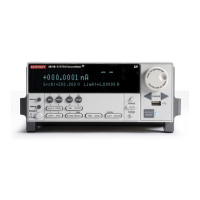10-12 Return to Section Topics 2600S-901-01 Rev. C / January 2008
Section 10: Digital I/O and Triggering Series 2600 System SourceMeter® Instruments Reference Manual
Triggering
Triggering types
A trigger initiates an event within the Series 2600 SourceMeter. In general, there are three types of
triggering:
• Measurement triggering — Used to initiate one or more measurements, to control the time
interval between measurements or the trigger and measurement, and to set the number of
measurements per trigger. See
"Measurement triggering" below for details.
• Digital I/O port triggering — Used to trigger external devices with pulses from the Digital I/
O port, and to trigger the Series 2600 from external control pulses applied to the Digital I/O
port (see
Section 10 for details).
• Display triggering — Used to trigger events with front panel keys
(see Section 14).
NOTE It is not necessary to change any trigger settings to use the basic
source and measurement procedures covered in this section. Simply
make sure that the unit is reset to the factory default conditions by
using the MENU > SETUP > RECALL > FACTORY option before
using those procedures.
Measurement triggering
Figure 10-5 shows the general sequence for measurement triggering. The basic sequence is as
follows:
• When the output is turned on, the programmed source value is immediately applied to the
DUT.
• For front panel operation, if the immediate trigger source is selected, a measurement will be
triggered immediately. However, if the manual trigger source is selected, the front panel
TRIG key must be pressed.
• For remote operation, the unit waits the programmed timeout period for a GET (GPIB only)
or *TRG (both interfaces) trigger command.
• The unit waits for the programmed delay period (if any).
• The instrument takes one measurement.
• If the number of measurements is less than the programmed trigger count, the unit cycles
back to take another measurement (the measurement cycle will be repeated indefinitely if
the infinite trigger count is selected).
• For multiple measurements, the unit waits for the programmed trigger interval (if any) before
taking the next measurement.

